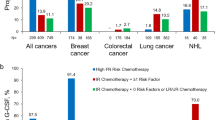Abstract
Objective
This study evaluated the prevalence, impact and predictive factors for the occurrence of febrile neutropenia (FN) in elderly patients receiving adjuvant myelosuppressive chemotherapy despite primary prophylaxis with G-CSF (breakthrough FN).
Methods
This was a single-centre, observational, retrospective cohort study. Elderly cancer patients (≥65 years old) who have received adjuvant chemotherapy with primary prophylaxis using G-CSF from Jan 2008 to Aug 2011 were included. Variables identified by the univariate analysis as being associated with FN were included in a multivariable logistic model to investigate the independence of its association with FN.
Results
One hundred and forty-five patients and 704 cycles of chemotherapy were analyzed in this study, of which majority were Chinese (79.3 %). The median age of the patients was 69 years old (IQR: 66, 74). Majority of these patients were diagnosed with lymphoma (54.5 %), followed by breast cancer (34.5 %) and small cell lung cancer (8.3 %). In total, 24 patients (16.6 %) manifested at least one episode of FN, of which 41.7 % occurred during the first cycle of treatment. Only a minority of FN patients had clinically significant dose delay or reduction (25.0 % and 12.5 %, respectively). After adjustment with confounders (gender, baseline lymphocyte counts and baseline absolute neutrophil counts), patients with ≥2 comorbidities were at higher risk to develop breakthrough FN (AOR = 4.42, 95 %CI: 1.36–14.40, p = 0.014).
Conclusion
Breakthrough FN is prevalent among elderly cancer patients receiving adjuvant chemotherapy despite G-CSF support, particularly among patients with more than two comorbidities.
Similar content being viewed by others
References
National Comprehensive Cancer Network. Myeloid Growth Factors. www.nccn.org/professionals/physicians_gls/pdf/myeloidgrowth.pdf. Accessed 23 Feb 2013
Aapro MS, Cameron DA, Pettengell R et al (2006) EORTC guidelines for the use of granulocyte-colony stimulating factor to reduce the incidence of chemotherapy-induced febrile neutropenia in adult patients with lymphomas and solid tumours. Eur J Cancer 42:2433–2453
Smith TJ, Khatcheressian J, Lyman GH et al (2006) 2006 update of recommendations for the use of white blood cell growth factors: an evidence-based clinical practice guideline. J Clin Oncol 24:3187–3205
Aapro M, Schwenkglenks M, Lyman GH et al (2010) Pegfilgrastim primary prophylaxis vs. current practice neutropenia management in elderly breast cancer patients receiving chemotherapy. Crit Rev Oncol Hematol 74:203–210
Lyman GH, Kuderer NM, Crawford J et al (2011) Predicting individual risk of neutropenic complications in patients receiving cancer chemotherapy. Cancer 117:1917–1927
Aapro M, Crawford J, Kamioner D (2010) Prophylaxis of chemotherapy-induced febrile neutropenia with granulocyte colony-stimulating factors: where are we now? Support Care Cancer 18:529–541
Balducci L, Hardy CL, Lyman GH (2001) Hematopoietic growth factors in the older cancer patient. Curr Opin Hematol 8:170–187
Aapro MS, Bohlius J, Cameron DA et al (2011) 2010 update of EORTC guidelines for the use of granulocyte-colony stimulating factor to reduce the incidence of chemotherapy-induced febrile neutropenia in adult patients with lymphoproliferative disorders and solid tumours. Eur J Cancer 47:8–32
Segal BH, Freifeld AG, Baden LR et al (2008) Prevention and treatment of cancer-related infections. J Natl Compr Canc Netw 6:122–174
Jenkins P, Freeman S (2009) Pretreatment haematological laboratory values predict for excessive myelosuppression in patients receiving adjuvant FEC chemotherapy for breast cancer. Ann Oncol 20:34–40
Chan A, Chen C, Chiang J et al (2012) Incidence of febrile neutropenia among early-stage breast cancer patients receiving anthracycline-based chemotherapy. Support Care Cancer 20:1525–1532
Chan A, Fu WH, Shih V et al (2011) Impact of colony-stimulating factors to reduce febrile neutropenic events in breast cancer patients receiving docetaxel plus cyclophosphamide chemotherapy. Support Care Cancer 19:497–504
The International Non-Hodgkin's Lymphoma Prognostic Factors Project (1993) A predictive model for aggressive non-Hodgkin’s lymphoma. N Engl J Med 329:987–994
Coiffier B, Lepage E, Briere J et al (2002) CHOP chemotherapy plus rituximab compared with CHOP alone in elderly patients with diffuse large-B-cell lymphoma. N Engl J Med 346:235–242
Coiffier B, Thieblemont C, Van Den Neste E et al (2010) Long-term outcome of patients in the LNH-98.5 trial, the first randomized study comparing rituximab-CHOP to standard CHOP chemotherapy in DLBCL patients: a study by the Groupe d’Etudes des Lymphomes de l’Adulte. Blood 116:2040–2045
Salar A, Haioun C, Rossi FG et al (2012) The need for improved neutropenia risk assessment in DLBCL patients receiving R-CHOP-21: findings from clinical practice. Leuk Res 36:548–553
Rajan SS, Stearns SC, Lyman GH et al (2011) Effect of primary prophylactic G-CSF use on systemic therapy administration for elderly breast cancer patients. Breast Cancer Res Treat 130:255–266
Pettengell R, Bosly A, Szucs TD et al (2009) Multivariate analysis of febrile neutropenia occurrence in patients with non-Hodgkin lymphoma: data from the INC-EU Prospective Observational European Neutropenia Study. Br J Haematol 144:677–685
Cullen M, Steven N, Billingham L et al (2005) Antibacterial prophylaxis after chemotherapy for solid tumors and lymphomas. N Engl J Med 353:988–998
Conflict of interest
The authors have no conflicts of interest that are directly relevant to the content of this study.
Author information
Authors and Affiliations
Corresponding author
Rights and permissions
About this article
Cite this article
Chan, A., Lee, C.P., Chiang, J. et al. Breakthrough febrile neutropenia and associated complications among elderly cancer patients receiving myelosuppressive chemotherapy for solid tumors and lymphomas. Support Care Cancer 21, 2137–2143 (2013). https://doi.org/10.1007/s00520-013-1768-9
Received:
Accepted:
Published:
Issue Date:
DOI: https://doi.org/10.1007/s00520-013-1768-9




